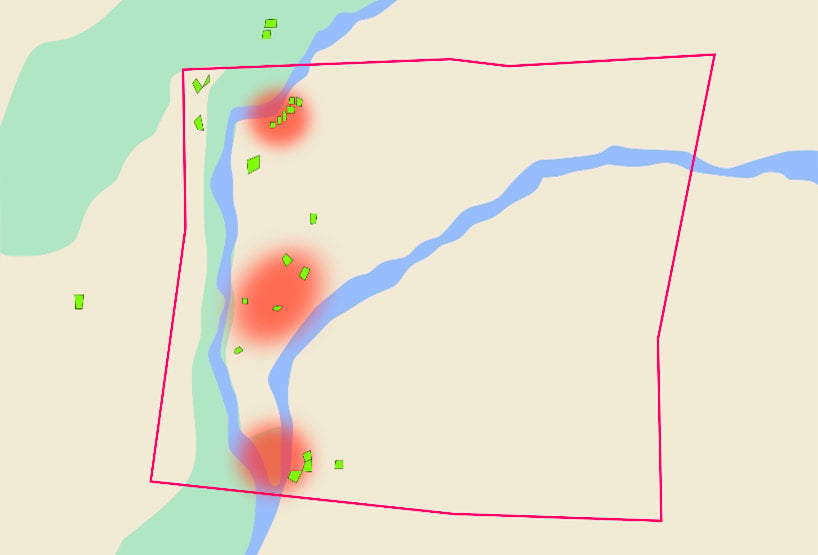www.ptreview.co.uk
29
'23
Written on Modified on
NEC TECHNOLOGY SUCCESSFULLY PREDICTS HIGH RISK AREAS FOR PRESENCE OF LANDMINES
High accuracy of prediction (approximately 90%) can contribute to safer, more rapid and efficient landmine removal.

Comparison between the AI-predicted mine burial area (red circles) and the actual burial location (yellow-green dots)
(Pre-identify the area to be predicted by AI (red square frame))
NEC Corporation has successfully conducted experiments with AI to predict the likelihood of landmines being buried in certain areas. This project was conducted to contribute to the reduction of casualties from landmines and to support their safe, prompt, and efficient removal. As a result of this work, it was confirmed that the most likely position of landmines can be predicted with a high degree of accuracy (about 90%). This work was conducted as part of a co-creation project with the International Committee of the Red Cross (ICRC) that began in June 2021.
Landmines are often placed so that they are difficult to detect, and because they are buried in areas where people and vehicles frequently pass, they continue to pose a threat to human life, even after conflicts have ended. In 2021, the number of casualties caused by Explosive Remnants of War (ERW), such as cluster bombs and landmines, reached 5,554 worldwide, most of which were civilians. In addition, land development is difficult in areas where landmines may be buried, hindering economic development.
For this project, NEC received open data from the ICRC, such as geographical and geological information, data that included the locations of habitation and important buildings, as well as reports from residents. NEC's AI then selected and analyzed the information to predict areas with a high probability of landmines. Based on information about conflict areas, NEC has used this technology to achieve a prediction match rate of approximately 90%, with the predictions indicating both likely landmine areas and areas that are likely free from landmines.
As a result, it will be possible for the small number of demining experts and personnel around the world to survey larger areas of land faster and at a lower cost. The first stages of demining conventionally require many people and a great deal of time to sort through large amounts of data and information. By using AI to sort (or “harmonize") this data and information, human experts can focus on making decisions about where to conduct landmine removal in the most efficient way.
Going forward, the system will also incorporate new sources of data such as remote sensing (e.g., data gathered from drones and satellites), to further improve the speed and accuracy of forecasts. Moreover, by March 2024, NEC aims to provide an AI-enabled prediction solution for landmine areas to governments and international organizations around the world. This project is aligned with NEC's vision to realize a sustainable society in which everyone can reach their full potential by integrating advanced ICT and knowledge for the benefit of all.
(Pre-identify the area to be predicted by AI (red square frame))
NEC Corporation has successfully conducted experiments with AI to predict the likelihood of landmines being buried in certain areas. This project was conducted to contribute to the reduction of casualties from landmines and to support their safe, prompt, and efficient removal. As a result of this work, it was confirmed that the most likely position of landmines can be predicted with a high degree of accuracy (about 90%). This work was conducted as part of a co-creation project with the International Committee of the Red Cross (ICRC) that began in June 2021.
Landmines are often placed so that they are difficult to detect, and because they are buried in areas where people and vehicles frequently pass, they continue to pose a threat to human life, even after conflicts have ended. In 2021, the number of casualties caused by Explosive Remnants of War (ERW), such as cluster bombs and landmines, reached 5,554 worldwide, most of which were civilians. In addition, land development is difficult in areas where landmines may be buried, hindering economic development.
For this project, NEC received open data from the ICRC, such as geographical and geological information, data that included the locations of habitation and important buildings, as well as reports from residents. NEC's AI then selected and analyzed the information to predict areas with a high probability of landmines. Based on information about conflict areas, NEC has used this technology to achieve a prediction match rate of approximately 90%, with the predictions indicating both likely landmine areas and areas that are likely free from landmines.
As a result, it will be possible for the small number of demining experts and personnel around the world to survey larger areas of land faster and at a lower cost. The first stages of demining conventionally require many people and a great deal of time to sort through large amounts of data and information. By using AI to sort (or “harmonize") this data and information, human experts can focus on making decisions about where to conduct landmine removal in the most efficient way.
Going forward, the system will also incorporate new sources of data such as remote sensing (e.g., data gathered from drones and satellites), to further improve the speed and accuracy of forecasts. Moreover, by March 2024, NEC aims to provide an AI-enabled prediction solution for landmine areas to governments and international organizations around the world. This project is aligned with NEC's vision to realize a sustainable society in which everyone can reach their full potential by integrating advanced ICT and knowledge for the benefit of all.
www.nec.com

